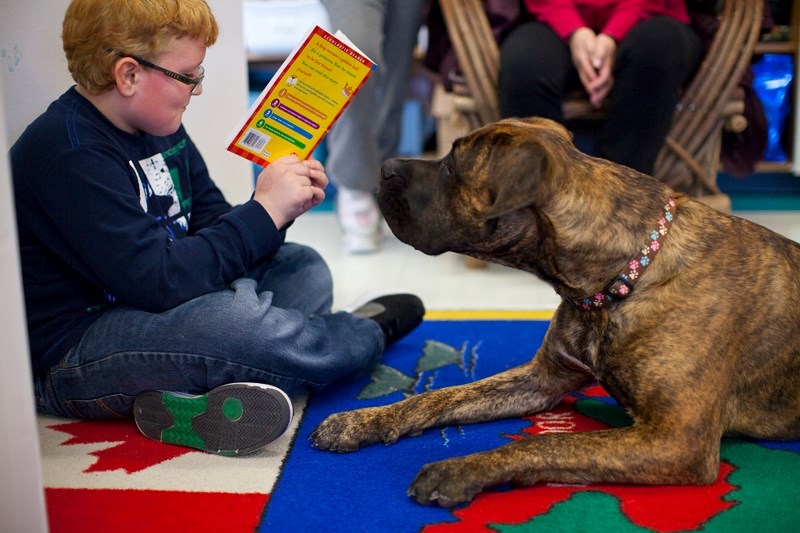One local teacher has taken a different approach to helping students overcome their learning difficulties by partnering them with a dog and dog owner to practise their reading skills.
Carrie Krause, a Grade 4 teacher at Olds Elementary School, came up with the idea earlier this school year after noticing that many students in her class were having difficulty with various aspects of learning.
“In the last 10 years we've noticed that learning disabilities is on the increase. There are more kids with especially reading and writing challenges and …this year I have a class of students where quite a few have issues reading and writing,” she said.
Krause said by the time students get to her classroom, they realize they have difficulty with various aspects of learning. It also gets more difficult to engage them in the learning process because they have developed certain topics of interest and those books are often more advanced. Often, she said, more boys than girls have reading difficulties.
“They want to read about skateboarding and snowmobiling and (sports) heroes … and sometimes those books are hard to find because usually by the time they're into that stuff those books are a lot harder to read,” she said.
Because there are several students in her classroom with learning difficulties, Krause said she has noticed they become less self-confident and aren't as interested in reading.
Krause thought about the issue and thought that if dogs can help with physical issues, they might be able to help with learning difficulties as well. She did some research on the Internet and found some reading programs existed in the United States.
“So I thought I'll read what I can about the other programs and adapt it to suit the needs of my classroom and the kids that I'm working with,” she said.
Krause then approached school administrators with the idea and found they were extremely supportive of it.
Principal Ray Hoppins said when he was approached with the idea, he thought it was a great way to overcome the issue of engaging students in learning basic skills.
“I thought it was just another excellent example of a unique and creative way to build confidence in kids. But at the same time it didn't surprise me because Mrs. Krause is very creative and innovative,” he said.
Hoppins said Krause is one of many teachers at the school who demonstrate creativity and a willingness to try unconventional methods to help students succeed.
Once Krause received the support of administration, she said she worried she wouldn't be able to find any volunteers willing to bring in their dogs for the program. In addition, the animals had to be suitable to be able to listen to the students read.
Using newsletters and word of mouth, Krause found eight owners and nine dogs that were suitable and willing to give the program a try. She said both the dogs and volunteers have been excellent in the classroom, spending about 30 minutes every school day with the students.
Krause said since the program started in mid-October, it has been working well. In order to separate the general class from the student that is reading to a dog, Krause made a tri-fold so that the student that is reading is less self-conscious that others are watching.
“There are a lot of things I do in my class to help these kids. This is just another way (to help) and you never know which way is going to work for a kid. Any way you can put out there, I think, is worth it,” she said.
“The kids really like it. They're excited,” she said, noting that every student takes a turn reading to the dogs.
Every dog that participates in the program is a different breed, which Krause said is advantageous because some students might be more comfortable with one dog over another.
“Generally speaking, when a well-trained dog like the dogs that are in this program come in, kids just seem to love them all,” she said, noting that she lets the students decide how much interaction they will have with the dogs.
Quenton Bullock, one of the students in the class, said he likes the fact that the dogs don't judge him.
“And also how the dogs always listen . . . and also when the dogs just sit down and listen all the way through, they don't say your words are wrong and … it doesn't matter how you do it,” he said.
"I thought it was just another excellent example of a unique and creative way to build confidence in kids."Ray Hoppins, principal, Olds Elementary School



